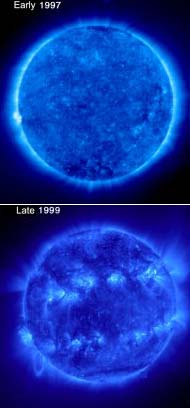XMM-Newton detects X-ray ’solar cycle’ in distant star

The Sun as observed by the ESA/NASA SOHO observatory near the minimum of the solar cycle (above) and near its maximum (below). The signs of solar activity near the maximum are clearly seen. New XMM-Newton observations suggest that this behaviour may be typical of stars like the Sun, such as HD 81809 in the constellation Hydra.
For years, astronomers have wondered whether stars similar to the Sun go through periodic cycles of enhanced X-ray activity, like those often causing troubles to telephone and power lines here on Earth.
ESA’s X-ray observatory XMM-Newton has now revealed for the first time a cyclic behaviour in the X-ray radiation emitted by a star similar to the Sun. This discovery may help scientists to understand how stars affect the development of life on their planets.
Since the time Galileo discovered sunspots, in 1610, astronomers have measured their number, size and location on the disc of the Sun. Sunspots are relatively cooler areas on the Sun that are observed as dark patches. Their number rises and falls with the level of activity of the Sun in a cycle of about 11 years.
When the Sun is very active, large-scale phenomena take place, such as the flares and coronal mass ejections observed by the ESA/NASA solar observatory SOHO. These events release a large amount of energy and charged particles that hit the Earth and can cause powerful magnetic storms, affecting radio communications, power distribution lines and even our weather and climate.
During the solar cycle, the X-ray emission from the Sun varies by a large amount (about a factor of 100) and is strongest when the cycle is at its peak and the surface of the Sun is covered by the largest number of spots.
ESA’s X-ray observatory, XMM-Newton, has now shown for the first time that this cyclic X-ray behaviour is common to other stars as well. A team of astronomers, led by Fabio Favata, from ESA’s European Space Research and Technology Centre, The Netherlands, has monitored a small number of solar-type stars since the beginning of the XMM-Newton mission in 2000. The X-ray brightness of HD 81809, a star located 90 light years away in the constellation Hydra (the water snake), has varied by more than 10 times over the past two and a half years, reaching a well defined peak in mid 2002.
The star has shown the characteristic X-ray modulation (brightening and dimming) typical of the solar cycle. “This is the first clear sign of a cyclic pattern in the X-ray emission of stars other than the Sun,” said Favata. Furthermore, the data show that these variations are synchronised with the starspot cycle. If HD 81809 behaves like the Sun, its X-ray brightness can vary by a factor of one hundred over a few years. “We might well have caught HD 81809 at the beginning of an X-ray activity cycle,” added Favata.
The existence of starspot cycles on other stars had already been established long ago, thanks to observations that began in the 1950s. However, scientists did not know whether the X-ray radiation would also vary with the number of starspots. ESA’s XMM-Newton has now shown that this is indeed the case and that this cyclic X-ray pattern is not typical of the Sun alone. “This suggests that our Sun’s behaviour is probably nothing exceptional,” said Favata.
Besides its interest for scientists, the Sun’s cyclical behaviour can have an influence on everyone on Earth. Our climate is known to be significantly affected by the high-energy radiation emitted by the Sun. For instance, a temporary disappearance of the solar cycle in the 18th century corresponded with an exceptionally cold period on Earth. Similarly, in the early phases of the lifetime of a planet, this high-energy radiation has a strong influence on the conditions of the atmosphere, and thus potentially on the development of life.
Finding out whether the Sun’s X-ray cycle is common among other solar-type stars, and in particular among those hosting potential rocky planets, can give scientists much needed clues on whether and where other forms of life might exist outside the Solar System. At the same time, understanding how typical and long-lasting is the solar behaviour will tell us more about the evolution of the climate on Earth.
Further observations of HD 81809 and other similar stars are already planned with XMM-Newton. They will allow astronomers to study whether the large modulations in X-ray brightness observed in the Sun are indeed the norm for stars of its type. Understanding how other solar-like stars behave in general will give scientists better insight into the past and future of our own Sun.
Media Contact
More Information:
http://www.esa.int/esaCP/SEMFALGHZTD_index_1.htmlAll latest news from the category: Physics and Astronomy
This area deals with the fundamental laws and building blocks of nature and how they interact, the properties and the behavior of matter, and research into space and time and their structures.
innovations-report provides in-depth reports and articles on subjects such as astrophysics, laser technologies, nuclear, quantum, particle and solid-state physics, nanotechnologies, planetary research and findings (Mars, Venus) and developments related to the Hubble Telescope.
Newest articles

High-energy-density aqueous battery based on halogen multi-electron transfer
Traditional non-aqueous lithium-ion batteries have a high energy density, but their safety is compromised due to the flammable organic electrolytes they utilize. Aqueous batteries use water as the solvent for…

First-ever combined heart pump and pig kidney transplant
…gives new hope to patient with terminal illness. Surgeons at NYU Langone Health performed the first-ever combined mechanical heart pump and gene-edited pig kidney transplant surgery in a 54-year-old woman…

Biophysics: Testing how well biomarkers work
LMU researchers have developed a method to determine how reliably target proteins can be labeled using super-resolution fluorescence microscopy. Modern microscopy techniques make it possible to examine the inner workings…





















